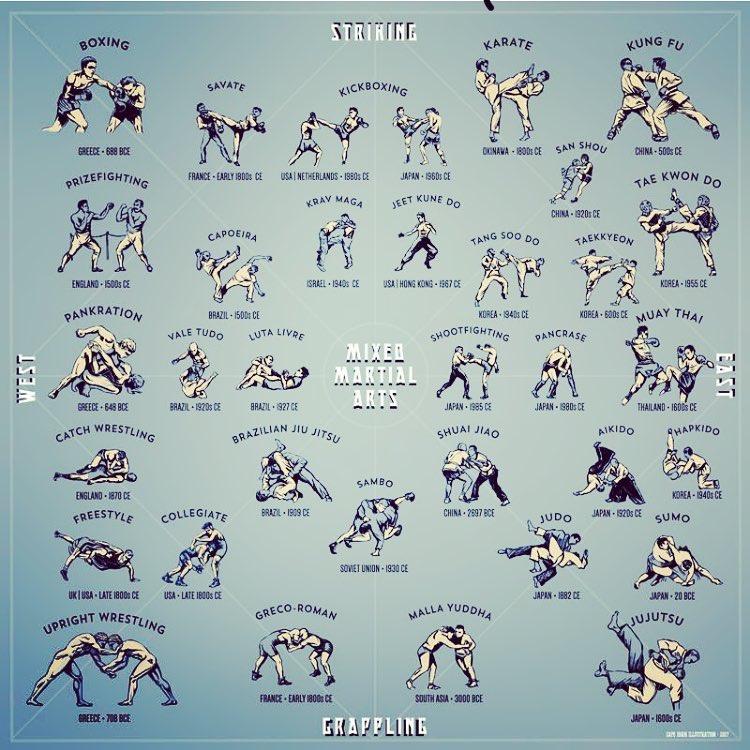The Background And Viewpoint Of Fighting Style: A Deep Dive
The Background And Viewpoint Of Fighting Style: A Deep Dive
Blog Article
Posted By-Fyhn Barbour
Enter the ancient world where martial arts were substantiated of necessity in varied regions. Cultures crafted unique battling styles intertwined with historical contexts. Strategies evolved over centuries through devoted practice and social exchanges. Today, contemporary martial arts mix typical components for maximum efficiency. Philosophically, martial arts highlight discipline, self-improvement, and consistency. Respect, humbleness, and balance are fundamental concepts guiding specialists in the direction of development and resilience. Check out the depths of this abundant history and philosophy to reveal the extensive impacts forming this long-lasting self-control.
Beginnings of Martial Arts
Fighting style came from numerous areas worldwide, developing as functional battle systems to defend against hazards. These old fighting styles were established out of need, with each society crafting techniques fit to their distinct environments and difficulties. From the grappling arts of Jujutsu in Japan to the striking techniques of Martial art in China, martial arts were deeply intertwined with the historical, social, and cultural fabric of their corresponding cultures.
In Japan, the samurai class polished martial arts like Kenjutsu, the art of the sword, which later on advanced into the more promoted form of Kendo. At the same time, in Brazil, Capoeira emerged as a blend of dance and combat, developed by enslaved Africans as a method to resist oppression. Each fighting style lugs with it an abundant history and approach, reflecting the worths and ideas of the people that practiced them.
As you delve into the beginnings of martial arts, you reveal a tapestry of human resourcefulness, strength, and the stubborn spirit of warriors throughout time.
Development of Methods
Via centuries of practice and improvement, combat strategies within numerous martial arts have undertaken a profound development. From old styles like Martial art and Martial arts to much more modern self-controls such as Brazilian Jiu-Jitsu and Krav Maga, the advancement of methods has been driven by a mix of cultural impacts, useful applications, and technological advancements.
One significant facet of this development is the cross-pollination of strategies between different martial arts. For example, strategies from standard Japanese Jiu-Jitsu were integrated right into the creation of Judo by Jigoro Kano in the late 19th century. This blending of styles has led to the advancement of hybrid martial arts like Mixed Martial Arts (MIXED MARTIAL ARTS), which combine elements of striking, grappling, and submission methods.
Furthermore, the advancement of methods has been shaped by the increasing focus on efficiency and effectiveness in combat. Experts have continuously sought to improve their strategies with strenuous training, trial and error, and competitors, resulting in the development of highly specialized and efficient battling styles. Overall, the advancement of strategies in martial arts shows the vibrant nature of combat and the ongoing mission for enhancement and development.
Philosophical Foundations
Discovering the underlying philosophical principles of martial arts offers understanding right into their core worths and directing ideas. At the heart of lots of martial arts disciplines is the principle of self-control itself. By educating adult beginner kick boxing and body to function as one natural unit, you cultivate self-control that expands beyond the dojo or gym into everyday life. This technique incorporates respect, humbleness, and self-discipline, forming not just your physical abilities but additionally your character.
One more fundamental thoughtful structure in martial arts is the idea of continuous self-improvement. The journey of understanding a martial art is nonstop, with professionals constantly aiming to much better themselves, both physically and psychologically. visit site on development fosters resilience, perseverance, and a growth state of mind that can be put on all facets of life.
Moreover, martial arts highlight the value of harmony and balance. Techniques are made to make use of an opponent's power versus them, highlighting the principle of producing and redirecting pressure instead of satisfying it head-on. This approach includes interpersonal relationships, promoting tranquil resolutions and mutual understanding. By accepting these thoughtful structures, martial musicians not just boost their battle abilities but also cultivate a way of living fixated personal growth, respect, and consistency.
Final thought
In conclusion, the history and viewpoint of martial arts supply an abundant tapestry of custom, discipline, and self-improvement.
Consider instance the tale of Bruce Lee, that changed martial arts by blending different styles and ideologies to create his very own one-of-a-kind kind of Jeet Kune Do.
With dedication and development, martial musicians continue to press borders and inspire others to reach their full potential both in fight and in life.
